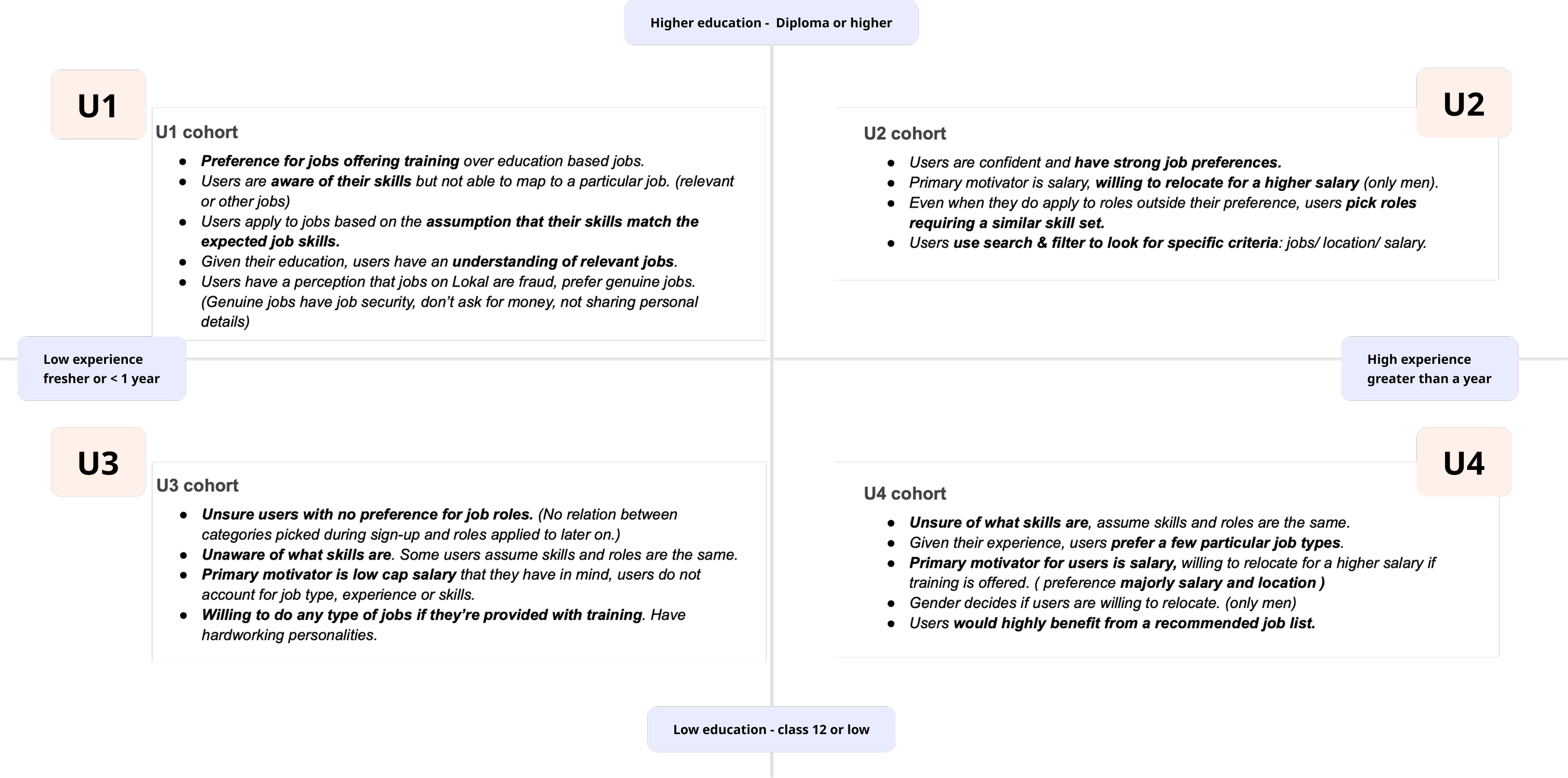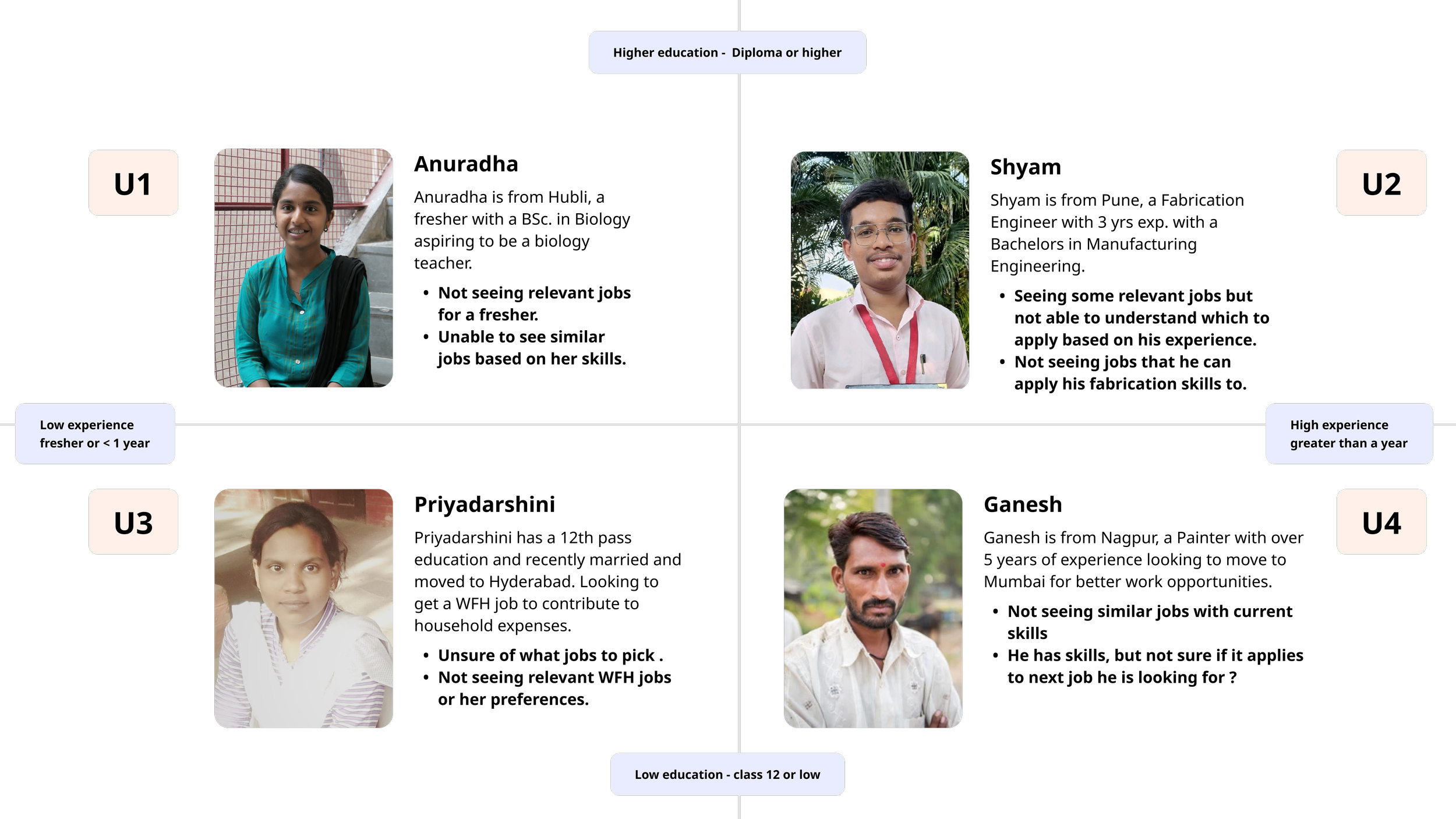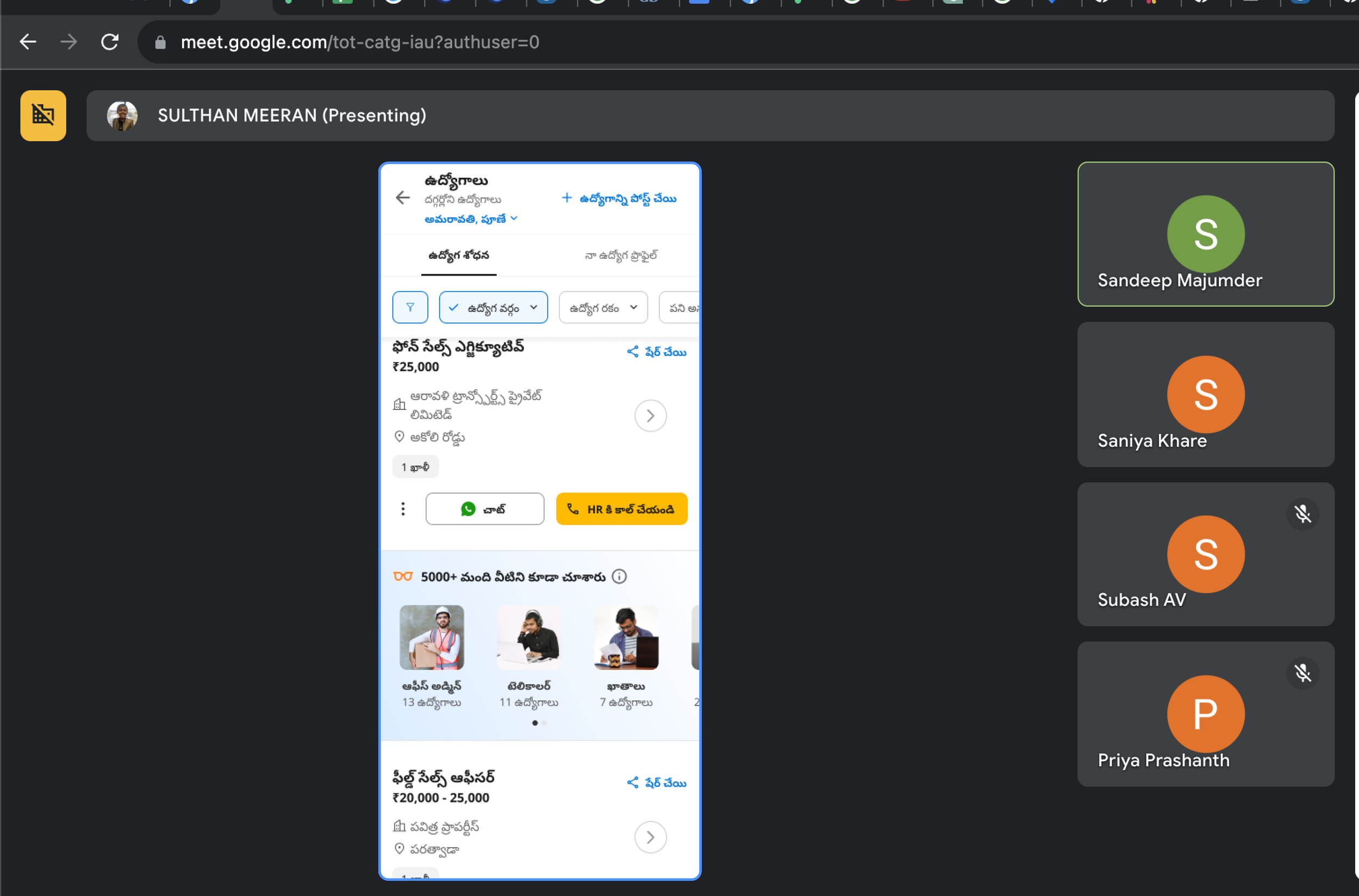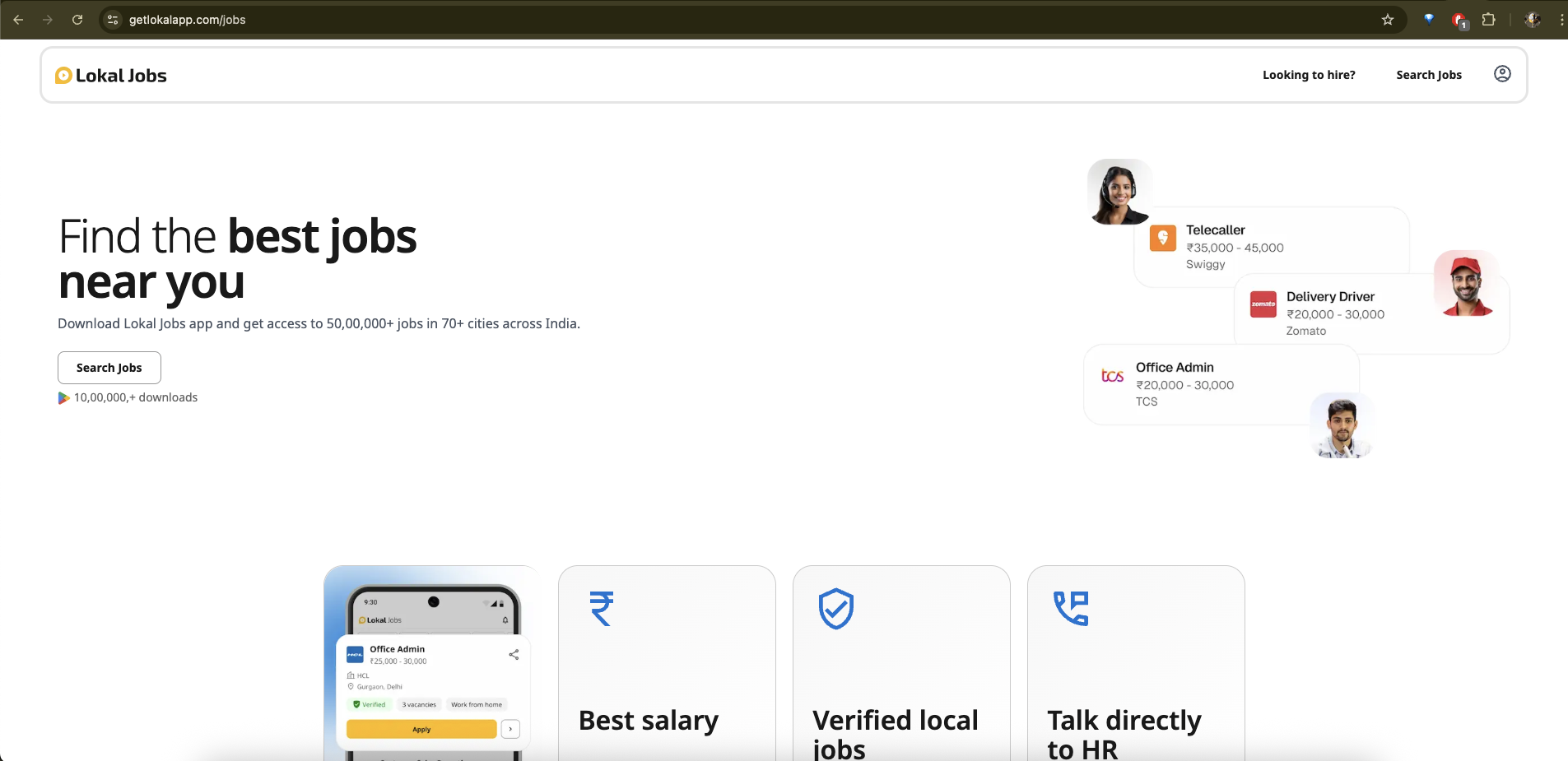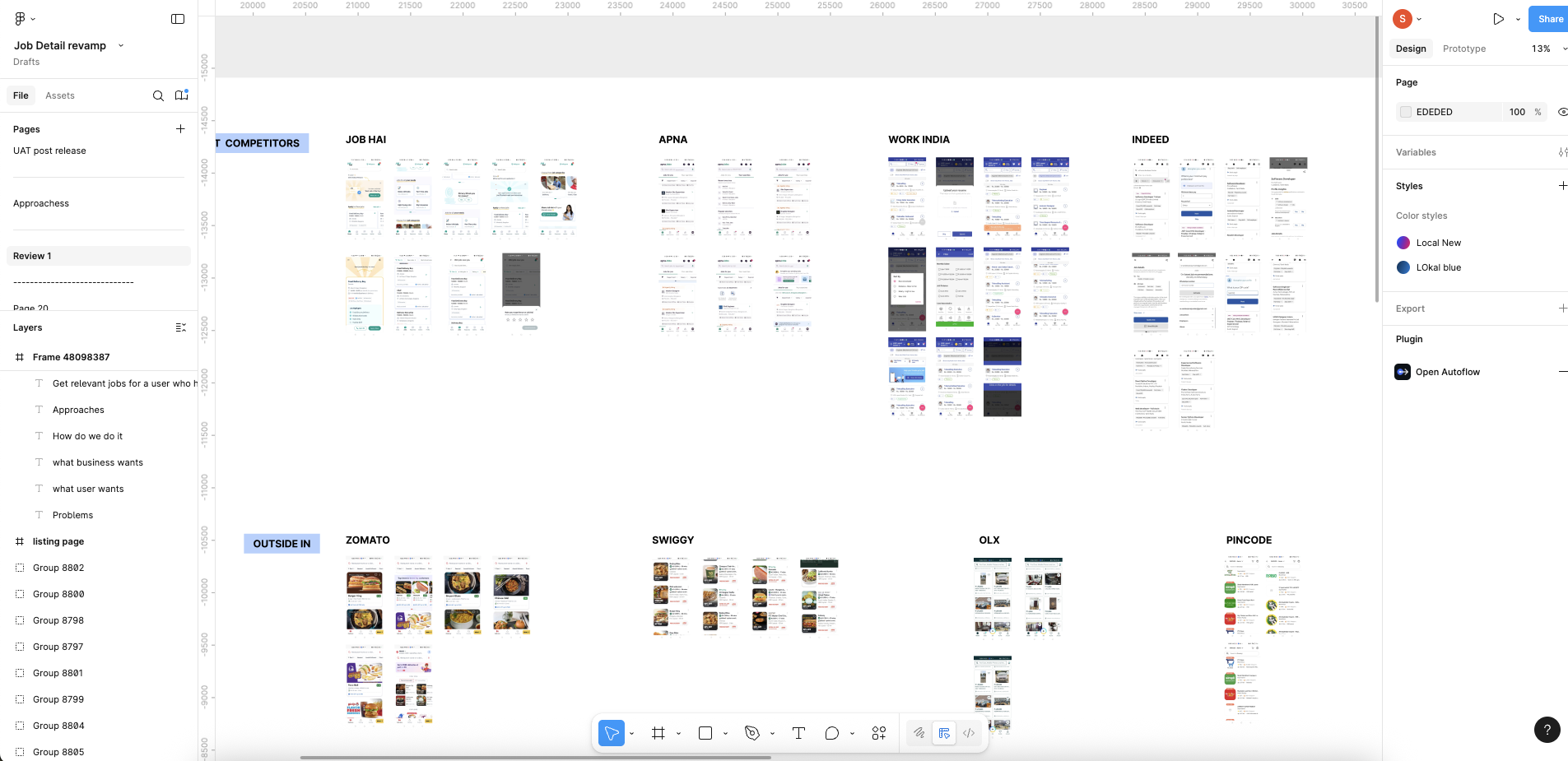Building relevancy of Jobs for seekers of tier 2 & 3 cities of India
Lokal Jobs is a hyperlocal employment platform that connects users from Tier-2+ cities with job opportunities in their vicinity, making the process faster, simpler, and more accessible.
Image - Lokal Jobs app
Problem space
Understanding the triggers
The data showed a steep early drop-off: users were reaching the platform but leaving within seconds. Fewer than half of those who landed on the job feed interacted meaningfully with the listings. The average interaction depth was only 2.5 job cards significantly below typical market benchmarks and indicative of low engagement with the page.
Image - Job profile creation funnel
Image - Job listing page user funnel
Lokal Jobs seekers - 6 months data from POD review
Looking at the funnels
Deeper analysis showed major drop-offs across both profile creation and the job-listing journey. More than half the users who logged in abandoned the process while entering personal details and selecting a job category, leaving only a small fraction reaching the Job Listing Page.
Among the organic users who did reach the JLP, fewer than 30% clicked a job card, only 15% of those initiated an application, and just 5% fully completed their profile and uploaded a resume.
Issues of Listing page logic
A lot of categories and primary roles overlap.
3 level of selection thereby diluting relevant job for user.
Jobs not mapped to any preference or skills from user side
Hypothesis
Based on Smartlook interactions and Mix panel data over a period of 6 months these are some of the hypothesis that needed to validated
A single category can include widely varying roles requiring different skill levels (e.g., the Admin/Office category ranges from office boy to admin manager).
Seekers may not meet the skill requirements for certain roles within the same category.
Seekers are better matched to roles outside their primary category (e.g., an office boy under ‘Admin’ may also fit well in ‘Delivery’ roles).
Seekers without a completed profile, job listings are shown jobs purely based on recency, not relevance.
User Journey Mapping
Our users
In efforts of first hand understanding of what was happening, we made trips to areas of Bangalore and Salem to understand why users were dropping off
What our users had to say ?
ನಾನು ಎರಡು ಭಾಗಕಾಲದ ಕೆಲಸಗಳನ್ನು ಮಾಡುವುದರಿಂದ ಪ್ಲಾಟ್ಫಾರ್ಮ್ನಲ್ಲಿ ವಿವಿಧ ಕೆಲಸಗಳನ್ನು ನೋಡುತ್ತೇನೆ, ಆದರೆ ಇಲ್ಲಿ ನನಗೆ ಸೂಕ್ತವಾದ ಕೆಲಸವನ್ನು ಹುಡುಕುವುದು ತುಂಬಾ ಕಷ್ಟ
" I browse different jobs on the platform since I work two part-time roles, but finding the right job here is quite difficult for me."
நான் BSc முடித்திருக்கிறேன், ஆனால் எனக்கு காட்டப்படும் வேலைகள் எனக்கு உண்மையில் பொருத்தமா என்று எனக்கு உறுதியில்லை.
Understanding the user
Image - Lokalapp jobs users from Bangalore and Salem
"I'm a BSc graduate, but I'm not sure whether the jobs shown to me are actually relevant"
ಸಾಮಾನ್ಯವಾಗಿ 나는 ವರ್ಷದಲ್ಲಿ ಹಲವು ರೀತಿಯ ಕೆಲಸಗಳನ್ನು ಮಾಡುತ್ತೇನೆ, ಆದರೆ ಲೋಕಲ್ನಲ್ಲಿ ಡೆಲಿವರಿ ಕೆಲಸಗಳ ಹೊರತಾಗಿ ಬೇರೆ ಕೆಲಸಗಳನ್ನು ನಾನು ಹುಡುಕಬಹುದೇ ಎಂಬುದು ನನಗೆ ಸ್ಪಷ್ಟವಾಗಿಲ್ಲ
"I usually switch between different jobs throughout the year, but on Lokal I’m not sure whether I can explore other types of work beyond delivery roles."
User Research Findings
Persona Cohorting
Insights to work upon
Enhance relevancy of jobs for users
Reduce cognitive load for users to ensure easy consumption of information
The Opportunities
How might we enhance
job relevancy
Opportuntiites Mapping
Through opportunity mapping, I converted user frustrations and behavioural patterns into clear, actionable focus areas. This helped me identify the strongest levers for improving the platform thereby enhancing job relevancy to reducing cognitive load and enabling frictionless, guided interactions.
How might we
reduce cognitive load
The Approach
The goal was to first classify all jobs in the pipeline into clear cohorts, making it easier to match them with the right groups of job seekers.
Job Cohorting
Design decisions
Showing roles rather than broader categorisation
2 level of input from user.
Skills data mapped to.use cohorts
Less data points during profile making
System Mapping
Cohorting Logic
Listing Logic
Defining the funnels
User intent is highest the moment they enter the Jobs section and drops afterward. To maximize relevance, essential information is collected immediately, while deeper details are requested later only when needed for their cohort.
Design for High Intent - Education, Experience & Location
Design for Medium to Low Intent - Job Roles & skills
Job Listing Page
The Solution
Testiing
Based on various design iterations, user testing was conducted and A/B tests were run to arrive at the above designs , these are few learnings
A single solution cannot meet the rapidly shifting needs of Tier-2+ job seekers; their preferences and circumstances change frequently.
Seekers equate “genuine jobs” with “good jobs,” making trust a critical factor in attracting and retaining them.
Users continue using the platform and even recommend it to friends only if they see immediate value; loyalty in Tier 2 & 3 markets is high when expectations are met quickly.
Even when users create a profile during onboarding, it becomes outdated fast; most seekers change jobs within six months, so profiles need regular updates.
Tracking the metrics
User interaction increased to an all time high of 43% with profile creation rate increased to 40%
My learning
The major learnings that I had as a designer on this project are
Cohorting users based on their diverse needs is essential when designing for Bharat.
What users say often differs from what they actually need, so observing real behaviour becomes crucial.
Cultural nuances significantly influence decision-making and application behaviour, especially in Tier-2 regions.
Image - Jobs Website
Way forward
Efforts have been initiated to improve the Job Details page, strengthen job recommendations, and reduce fraud on the platform.



